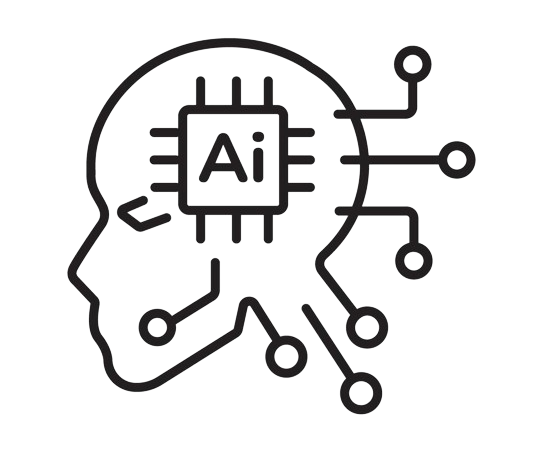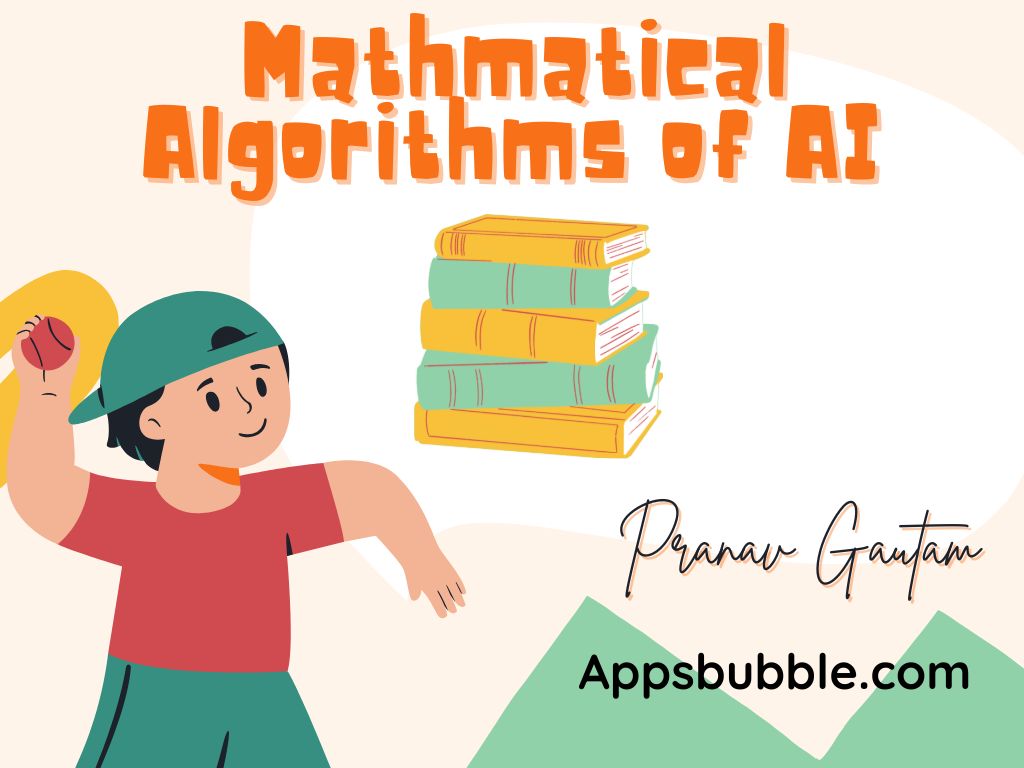Mathematical Foundations of Artificial Intelligence
The Mathematical Foundations of Artificial Intelligence (AI) are essential for understanding how various AI algorithms work. This chapter typically covers key mathematical concepts that underpin AI techniques, including:
-
Linear Algebra
-
Probability and Statistics
-
Calculus
-
Optimization
-
Discrete Mathematics
Let’s go over a brief overview of each of these areas:
1. Linear Algebra
Linear Algebra is crucial for understanding data representation and manipulation in AI. It deals with vectors, matrices, and tensors, which are fundamental in many AI algorithms.
- Vectors: A vector is a list of numbers that represent a point or a direction in space. For instance, a 2D vector can be represented as [x,y][x, y]
- Matrices: A matrix is a two-dimensional array of numbers, which can represent data, transformations, or systems of equations. For example, a matrix AA can transform a vector xx into another vector yy using the matrix multiplication y=Axy = Ax.
- Tensors: Tensors generalize vectors and matrices to higher dimensions. They are widely used in deep learning for managing multi-dimensional data like images, video, and more.
Key operations include matrix multiplication, determinant calculation, eigenvectors and eigenvalues, and matrix inversion.
Problem 1: Principal Component Analysis (PCA)
Problem: Given the data points in 2D space: (2,3)(2, 3), (3,4)(3, 4), (4,5)(4, 5), (5,6)(5, 6), perform PCA and find the principal component direction.
Solution: PCA is a method used to reduce the dimensionality of data while preserving as much variance as possible. Here’s a step-by-step approach:
- Center the Data: Subtract the mean of each variable from the dataset.
- Mean of xx values: (2+3+4+5)/4=3.5(2 + 3 + 4 + 5) / 4 = 3.5
- Mean of yy values: (3+4+5+6)/4=4.5(3 + 4 + 5 + 6) / 4 = 4.5
- Centered data: (−1.5−1.5−0.5−0.50.50.51.51.5)\begin{pmatrix} -1.5 & -1.5 \\ -0.5 & -0.5 \\ 0.5 & 0.5 \\ 1.5 & 1.5 \end{pmatrix}
Python Implementation:
import numpy as np
data = np.array([[2, 3], [3, 4], [4, 5], [5, 6]])
mean = np.mean(data, axis=0)
centered_data = data – mean
cov_matrix = np.cov(centered_data, rowvar=False)
eigenvalues, eigenvectors = np.linalg.eigh(cov_matrix)
principal_component = eigenvectors[:, –1] # Largest eigenvector
print(principal_component)
2. Probability and Statistics
Probability and Statistics provide the tools for modeling uncertainty, making inferences from data, and learning from observations.
- Probability: This deals with the likelihood of events. Key concepts include probability distributions, conditional probability, and Bayes’ theorem.
Problem 1: Probability of an Event
Problem: A machine learning model has a 70% probability of correctly classifying an image as a cat and a 30% probability of incorrectly classifying it. If 10 images are classified, what is the probability that exactly 7 of them are classified correctly?
Python Implementation:
from scipy.stats import binom
n = 10
k = 7
p = 0.7
probability = binom.pmf(k, n, p)
print(probability)
- Statistics: This involves collecting, analyzing, and interpreting data. Important concepts include mean, variance, standard deviation, and hypothesis testing.
Probability and statistics are foundational for machine learning algorithms, particularly those in supervised learning, where we make predictions based on data.
3. Calculus
Calculus helps us understand changes and is vital for optimization problems in AI, especially in training neural networks.
- Differential Calculus: Focuses on the rate at which quantities change. The derivative measures the rate of change of a function. In machine learning, gradients (derivatives) are used in gradient descent algorithms to minimize loss functions.
- Integral Calculus: Deals with the accumulation of quantities and areas under curves. It is less directly used in most machine learning algorithms but can be important in certain areas like probabilistic reasoning and optimization.
Problem 1: Gradient Descent
Problem: Given the cost function J(θ)=θ2+4θ+4J(\theta) = \theta^2 + 4\theta + 4, find the value of θ\theta that minimizes the cost function using the gradient descent method with a learning rate of 0.1. Start from an initial guess of θ=0\theta = 0.
Solution: Gradient descent updates the parameter θ\theta iteratively using the formula:
θ=θ−α∂J∂θ\theta = \theta – \alpha \frac{\partial J}{\partial \theta}
where α\alpha is the learning rate.
- Compute the derivative of the cost function:
∂J∂θ=2θ+4\frac{\partial J}{\partial \theta} = 2\theta + 4
- Initialize θ\theta and set the learning rate α\alpha:
θ=0,α=0.1\theta = 0, \quad \alpha = 0.1
- Update θ\theta iteratively:
Iteration 1:
θ=θ−α(2θ+4)=0−0.1(2⋅0+4)=−0.4\theta = \theta – \alpha (2\theta + 4) = 0 – 0.1 (2 \cdot 0 + 4) = -0.4
Iteration 2:
θ=−0.4−0.1(2(−0.4)+4)=−0.4−0.1(−0.8+4)=−0.4−0.1(3.2)=−0.72\theta = -0.4 – 0.1 (2(-0.4) + 4) = -0.4 – 0.1(-0.8 + 4) = -0.4 – 0.1(3.2) = -0.72
Iteration 3:
θ=−0.72−0.1(2(−0.72)+4)=−0.72−0.1(−1.44+4)=−0.72−0.1(2.56)=−0.976\theta = -0.72 – 0.1 (2(-0.72) + 4) = -0.72 – 0.1(-1.44 + 4) = -0.72 – 0.1(2.56) = -0.976
Iteration 4:
θ=−0.976−0.1(2(−0.976)+4)=−0.976−0.1(−1.952+4)=−0.976−0.1(2.048)=−1.1808\theta = -0.976 – 0.1 (2(-0.976) + 4) = -0.976 – 0.1(-1.952 + 4) = -0.976 – 0.1(2.048) = -1.1808
Continue this process until convergence. The value of θ\theta that minimizes the cost function J(θ)J(\theta) is approximately −2-2, as expected from the derivative setting 2θ+4=02\theta + 4 = 0 (the analytical solution).
Python Implementation:
def gradient_descent(learning_rate=0.1, iterations=10):
theta = 0
for i in range(iterations):
gradient = 2 * theta + 4
theta = theta – learning_rate * gradient
print(f”Iteration {i+1}: theta = {theta}“)
return theta
theta_min = gradient_descent()
print(f”Minimum theta: {theta_min}“)
4. Optimization
Optimization is about finding the best solution from a set of possible solutions. In AI, we often optimize a cost function or objective function to find the best parameters for a model.
- Gradient Descent : A common optimization algorithm that iteratively adjusts parameters to minimize a cost function.Gradient Descent is a fundamental optimization algorithm widely used in machine learning and artificial intelligence. It is an iterative method used to find the minimum value of a cost function (also known as a loss function) by updating the parameters of a model. The goal is to adjust the model’s parameters to reduce the difference between the predicted values and the actual values.
Key Concepts of Gradient Descent
- Cost Function (Loss Function):
- The cost function J(θ)J(\theta) measures how well the model performs. It quantifies the error between the predicted outputs and the actual outputs.
- In the context of linear regression, the cost function is often the Mean Squared Error (MSE): J(θ)=12m∑i=1m(hθ(x(i))−y(i))2J(\theta) = \frac{1}{2m} \sum_{i=1}^{m} (h_{\theta}(x^{(i)}) – y^{(i)})^2 where mm is the number of training examples, hθ(x(i))h_{\theta}(x^{(i)}) is the predicted value, and y(i)y^{(i)} is the actual value.
- Gradient:
- The gradient is a vector of partial derivatives of the cost function with respect to the model’s parameters. It indicates the direction and rate of change of the cost function.
- For a parameter θj\theta_j, the partial derivative is denoted as ∂J∂θj\frac{\partial J}{\partial \theta_j}.
- Learning Rate (α\alpha):
- The learning rate is a small positive value that controls the size of the steps taken towards the minimum. It determines how much the parameters are updated in each iteration.
- A too-large learning rate can cause the algorithm to overshoot the minimum, while a too-small rate can make convergence slow.
- Convex Optimization: Involves optimizing convex functions, which have the property that any local minimum is also a global minimum, making optimization easier.Convex Optimization is a subfield of optimization that deals with the problem of minimizing (or maximizing) a convex function over a convex set. It is particularly significant in fields like machine learning and artificial intelligence because it guarantees that any local minimum is also a global minimum, which simplifies the optimization process.
Key Concepts in Convex Optimization
- Convex Functions:
- A function f:Rn→Rf: \mathbb{R}^n \to \mathbb{R} is convex if its domain is a convex set and if, for all x,y∈dom(f)x, y \in \text{dom}(f) and λ∈[0,1]\lambda \in [0, 1], the following inequality holds: f(λx+(1−λ)y)≤λf(x)+(1−λ)f(y)f(\lambda x + (1 – \lambda) y) \leq \lambda f(x) + (1 – \lambda) f(y)
- Geometrically, this means that the line segment between any two points on the graph of the function lies above the graph.
- Convex Sets:
- A set CC is convex if, for any two points x,y∈Cx, y \in C, the line segment connecting xx and yy lies entirely within CC. That is: λx+(1−λ)y∈Cfor all λ∈[0,1]\lambda x + (1 – \lambda) y \in C \quad \text{for all } \lambda \in [0, 1]
- Local and Global Minima:
- For convex functions, any local minimum is also a global minimum. This property greatly simplifies the optimization process because it eliminates the need to distinguish between local and global minima.
- The absence of local minima means that optimization algorithms can converge more reliably and efficiently.
5. Discrete Mathematics
Discrete Mathematics deals with structures that are fundamentally discrete rather than continuous. It includes:
1. Graph Theory
Graph Theory deals with the study of graphs, which are mathematical structures used to model pairwise relations between objects. Graphs consist of vertices (nodes) connected by edges (links). This field has numerous applications in computer science, particularly in modeling networks, optimization, and data structure algorithms.
Applications in AI and Beyond:
- Social Networks: Graphs can model social networks where nodes represent individuals and edges represent relationships or interactions. This helps in analyzing social dynamics, detecting communities, and predicting trends.
- Knowledge Graphs: In natural language processing and information retrieval, knowledge graphs represent relationships between entities (like people, places, events) and help in reasoning and answering complex queries.
- Molecular Structures: In chemistry and biology, graphs model molecular structures where atoms are nodes and chemical bonds are edges. This helps in understanding molecular properties and reactions.
- Routing and Navigation: Graphs model transportation networks, where nodes represent locations and edges represent routes. Algorithms like Dijkstra’s and A* are used for finding the shortest path.
- Machine Learning: Graph-based algorithms are used in semi-supervised learning, clustering, and network analysis.
2. Logic
Logic is the foundation of formal reasoning, essential in fields like computer science, mathematics, and AI. It involves the systematic study of valid inference, reasoning, and argumentation.
Applications in AI:
- Automated Reasoning: Logic is used in AI to build systems that can reason, prove theorems, and solve problems automatically.
- Expert Systems: These are AI systems that use logic to encode the knowledge of human experts in specific domains, allowing them to make decisions and provide explanations.
- Natural Language Processing (NLP): Logic helps in understanding the semantics and structure of language, enabling machines to process and understand human language.
- Formal Verification: Logic is used to prove the correctness of algorithms and systems, ensuring they behave as intended under all conditions.
3. Combinatorics
Combinatorics is the study of counting, arrangement, and combination of objects. It’s crucial in areas like algorithm design, complexity theory, and probability.
Applications in AI and Computing:
- Algorithm Analysis: Combinatorics helps in analyzing the complexity and efficiency of algorithms, particularly in counting the number of possible states or configurations.
- Machine Learning: It is used in understanding the sample complexity and generalization ability of learning algorithms.
- Cryptography: Combinatorial methods are used in designing cryptographic protocols and algorithms, particularly in counting the possible keys or configurations.
- Game Theory: It helps in analyzing the possible outcomes and strategies in games and decision-making scenarios.

